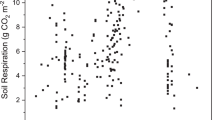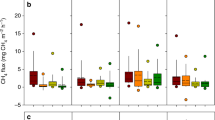Abstract
Peatlands act as global sinks of atmospheric carbon (C) through the accumulation of organic matter1, primarily made up of decay-resistant litter of peat mosses2. However, climate warming has been shown to promote vascular plant growth in peatlands, especially ericaceous shrubs3. A change in vegetation cover is in turn expected to modify above-ground/below-ground interactions4, but the biogeochemical mechanisms involved remain unknown. Here, by selecting peatlands at different altitudes to simulate a natural gradient of soil temperature, we show that the expansion of ericaceous shrubs with warming is associated with an increase of polyphenol content in both plant litter and pore water. In turn, this retards the release of nitrogen (N) from decomposing litter, increases the amount of dissolved organic N and reduces N immobilization by soil microbes. A decrease of soil water content with increasing temperature promotes the growth of fungi, which feeds back positively on ericaceous shrubs by facilitating the symbiotic acquisition of dissolved organic N. We also observed a higher release of labile C from vascular plant roots at higher soil temperatures, which promotes the microbial investment in C-degrading enzymes. Our data suggest that climate-induced changes in plant cover can reduce the productivity of peat mosses and potentially prime the decomposition of organic matter by affecting the stoichiometry of soil enzymatic activity.
This is a preview of subscription content, access via your institution
Access options
Subscribe to this journal
Receive 12 print issues and online access
$209.00 per year
only $17.42 per issue
Buy this article
- Purchase on Springer Link
- Instant access to full article PDF
Prices may be subject to local taxes which are calculated during checkout




Similar content being viewed by others
References
Limpens, J. et al. Peatlands and the carbon cycle: From local processes to global implications—a synthesis. Biogeosciences 5, 1475–1491 (2008).
Hajek, T., Balance, S., Limpens, J., Zijlstra, M. & Verhoeven, J. T. A. Cell-wall polysaccharides play an important role in decay resistance of Sphagnumand actively depressed decomposition in vitro. Biogeochemistry 103, 45–57 (2011).
Breeuwer, A. et al. Decreased summer water table depth affects peatland vegetation. Basic Appl. Ecol. 10, 330–339 (2009).
Meier, C. L. & Bowman, W. D. Links between plant litter chemistry, species diversity, and belowground ecosystem function. Proc. Natl Acad. Sci. USA 105, 19780–19785 (2008).
Dorrepaal, E. et al. Carbon respiration from subsurface peat accelerated by climate warming in the subarctic. Nature 460, 616–619 (2009).
Crow, S. E. & Wieder, R. K. Sources of CO2 emission from a northern peatland: Root respiration, exudation and decomposition. Ecology 86, 1825–1834 (2005).
Lipson, D. & Näsholm, T. The unexpected versatility of plants: Organic nitrogen use and availability in terrestrial ecosystems. Oecologia 128, 305–316 (2001).
Fierer, N., Craine, J. M., McLauchlan, K. & Schimel, J. P. Litter quality and the temperature sensitivity of decomposition. Ecology 86, 320–326 (2005).
Frei, C. et al. in Climate Change and Switzerland 2050: Expected Impacts on Environment, Society and Economy 12–23 (OcCC & ProClim, 2007).
Northup, R. R., Zengshou, Y., Dahigren, R. A. & Vogt, K. A. Polyphenol control of nitrogen release from pine litter. Nature 377, 227–229 (1995).
Smolander, A., Kanerva, S., Adamczyk, B. & Kitunen, V. Nitrogen transformations in boreal forest soils: Does composition of plant secondary compounds give an explanation? Plant Soil 350, 1–26 (2012).
Burke, R. M. & Cairney, J. W. C. Laccases and other polyphenol oxidases in ecto- and ericoid mycorrhizal fungi. Mycorrhiza 12, 105–116 (2002).
Bending, G. D. & Read, D. J. Nitrogen mobilization from protein-polyphenol complex by ericoid and ectomycorrhizal fungi. Soil Biol. Biochem. 28, 1603–1612 (1996).
Hobbie, E. A. & Hobbie, J. E. Natural abundance of 15N in nitrogen-limited forests and tundra can estimate nitrogen cycling through mycorrhizal fungi: A review. Ecosystems 11, 815–830 (2008).
Fierer, N., Schimel, J. P., Cates, R. G. & Zou, J. Influence of balsam poplar tannin fractions on carbon and nitrogen dynamics in Alaskan taiga floodplain soils. Soil Biol. Biochem. 33, 1827–2839 (2001).
Northup, R. R., Dahlgren, R. A. & McColl, J. G. Polyphenols as regulators of plant-litter-soil interactions in northern California’s pygmy forests: A positive feedback? Biogeochemistry 42, 189–220 (1998).
Murphy, M. T. & Moore, T. R. Linking root production to aboveground plant characteristics and water table in a temperate bog. Plant Soil 336, 219–231 (2010).
Fenner, N. & Freeman, C. Drought-induced carbon loss in peatlands. Nature Geosci. 4, 895–900 (2011).
Toberman, H., Freeman, C., Evans, C., Fenner, N. & Artz, R. R. E. Summer drought decreases soil fungal diversity and associated phenol oxidase activity in upland Calluna heathland soil. FEMS Microbiol. Ecol. 66, 426–436 (2008).
Sinsabaugh, R. L., Hill, B. H. & Follstad Shah, J. J. Ecoenzymatic stoichiometry of microbial organic nutrient acquisition in soil and sediment. Nature 462, 795–799 (2009).
Jaatinen, K., Fritze, H., Laine, J. & Laiho, R. Effects of short- and long-term water-level drawdown on the populations and activity of aerobic decomposers in a boreal peatland. Glob. Change Biol. 13, 491–510 (2007).
Mutabaruka, R., Hairiahb, K. & Cadisch, G. Microbial degradation of hydrolysable and condensed tannin polyphenol–protein complexes in soils from different land-use histories. Soil Biol. Biochem. 39, 1479–1492 (2007).
Keiblinger, K. M. et al. The effect of resource quantity and resource stoichiometry on microbial carbon-use-efficiency. FEMS Microbiol. Ecol. 73, 430–440 (2010).
Cleveland, C. C. & Liptzin, D. C:N:P stoichiometry in soils: Is there a ‘Redfield ratio’ for the microbial biomass? Biogeochemistry 85, 235–252 (2007).
Fenner, N. et al. Interactions between elevated CO2 and warming could amplify DOC exports from peatland catchment. Environ. Sci. Technol. 41, 3146–3152 (2007).
Garcia-Pausas, J. & Paterson, E. Microbial community abundance and structure are determinants of soil organic matter mineralization in the presence of labile carbon. Soil Biol. Biochem. 43, 1705–1713 (2011).
Fontaine, S. et al. Stability of organic carbon in deep soil layers controlled by fresh carbon supply. Nature 450, 277–281 (2007).
Fenner, N. et al. Elevated CO2 effects on peatland plant community carbon dynamics and DOC production. Ecosystems 10, 635–647 (2007).
Chong, M., Humphreys, E. & Moore, T. R. Microclimatic response to increasing shrub cover and its effect on Sphagnum CO2 exchange in a bog. Ecoscience 19, 89–97 (2012).
Chapin, F. S., Moilanen, L. & Kielland, K. Preferential use of organic nitrogen for growth by a non-mycorrhizal arctic sedge. Nature 361, 150–13 (1993).
Acknowledgements
We thank M. Lamentovicz, E. A. D. Mitchell, T. Spiegelberger, E. Feldmeyer-Christe, P. Gomez, A. Margot, P. Iacumin, G. Cavallo, R. Marchesini, J. D. Teuscher, E. Rossel, K. Vernez and J. D. Welch for assistance. The Service des Forêts, de la Faune et de la Nature (Canton de Vaud) and the Service de la promotion de la nature—Office de l’agriculture et de la nature (Canton de Berne) are acknowledged for giving the permission to access the study peatlands. This study was financially supported by the Swiss National Science Foundation (project ClimaBog, grant 205321-129981 to L.B.).
Author information
Authors and Affiliations
Contributions
L.B. and A.B designed the study; L.B. carried out the research with assistance from J.P. and A.B.; L.B. analysed the data with contribution from all the authors; L.B. and R.D.B. wrote the paper with contribution from A.B. and J.P.
Corresponding author
Ethics declarations
Competing interests
The authors declare no competing financial interests.
Supplementary information
Supplementary Information
Supplementary Information (PDF 241 kb)
Rights and permissions
About this article
Cite this article
Bragazza, L., Parisod, J., Buttler, A. et al. Biogeochemical plant–soil microbe feedback in response to climate warming in peatlands. Nature Clim Change 3, 273–277 (2013). https://doi.org/10.1038/nclimate1781
Received:
Accepted:
Published:
Issue Date:
DOI: https://doi.org/10.1038/nclimate1781
This article is cited by
-
Shifted plant composition predominantly controls nitrogen addition effect on community-level leaf nutrient resorption in a boreal peatland
Plant and Soil (2024)
-
Climate warming and elevated CO2 alter peatland soil carbon sources and stability
Nature Communications (2023)
-
Long-Term Phosphorus Addition Strongly Weakens the Carbon Sink Function of a Temperate Peatland
Ecosystems (2023)
-
Integrating water and insect pest management in agriculture
Journal of Pest Science (2023)
-
Whole-Ecosystem Warming Increases Plant-Available Nitrogen and Phosphorus in an Ombrotrophic Bog
Ecosystems (2023)



